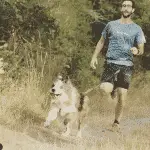Dogs are sociable animals. As a result, they find it difficult to stay alone, especially when they are not used to it: staying alone at home can be a source of anxiety for dogs. These anxieties can manifest themselves in several ways: barking and howling, destruction of furniture and objects… But then, what can you do when you are working? How do you teach your dog to stay alone? How long can a dog stay alone? Being away when you have a puppy is not always easy. In this article, we give you the keys to leave your dog alone at home in complete peace of mind.

1 – Leaving a dog alone: get your dog used to it as soon as possible
Loneliness is a real ordeal for an adult dog, which has never been left alone for very long. This is perfectly normal: the animal does not understand why his human is not there. He feels anxious, abandoned or simply bored. Note, however, that it is not recommended to take a dog to be left alone all day. Being sociable animals, dogs need contact. However, life circumstances, such as new work schedules, sometimes leave you with no choice but to leave your dog alone. It is therefore very important to get your dog used to being alone from an early age, so that he is not disturbed when you leave your home.
A puppy arriving in a new family is not used to being alone: until now, he has always been with his mother and siblings. It is out of the question to leave your puppy alone as soon as he arrives home. If you have the opportunity, take a few days off to welcome your companion and spend time with him. Your puppy needs to get used to his owners and his environment. After a few days, once you’ve established a bond of trust with your puppy and he’s settled in, you can begin to leave him alone. Some dogs, adopted as adults, also find it much harder to be left alone. In this case, it’s important to start learning to be alone gradually, just as if he were a puppy.
2 – Teach your dog independence
Adopting a new companion is always a great joy. We tend to be in constant contact with our companions when they have just arrived. This is not a good thing: your dog may not be happy about the separation if you have got him used to being constantly solicited. So teach your dog independence. It is not a question of not paying attention to him, but of allowing him to learn to look after himself. Make sure you include your dog in your daily life, without making him the centre of your world. Caressing, carrying and talking to your pet all the time makes him extremely dependent on you. If you get your pet used to this, it will be very difficult for him to live without you.
3 – Go crescendo
Start by leaving your dog alone for a few minutes to teach him to stay alone. Leaving the room while your dog is busy playing or eating is a good start. Return to the room after a minute – you don’t want your dog to miss you. That way, your dog will understand that you always come back when you leave. Is your puppy calm during these short absences? It’s time to take the next step: leave the room without your dog being busy. Once again, come back very quickly. Adopt normal behaviour so that your dog understands that it is natural for you to be away. If your dog remains calm, you can praise him. Gradually extend the time away from home and start to leave your home. Little by little, your dog will understand that he can stay alone and that he has no reason to be nervous.
4 – Don’t ritualise your departures and outings
Avoid ritualising your departures. Saying goodbye to your dog seems natural, but saying goodbye for too long can cause anxiety. So, before you leave your house or flat, get out of his sight and leave as if nothing had happened. Dogs are very intelligent animals: as soon as he sees you putting on your shoes and coat, your dog will understand that you are going out. So you can change your clothes before you go out, but also get dressed and then sit on your sofa, for example, for a few minutes. The aim is that your dog cannot anticipate your absence too much, and therefore have time to get anxious. Similarly, come back home without this being foreseeable for your dog: go out for 10 minutes, then 15, then 5, then an hour… This way, your dog won’t wait for you to come back after a specific period of time.
5 – Prepare your dog for solitude
It is out of the question to leave your dog for several hours without having prepared him for it. To begin, you must create a safe and pleasant environment for your companion. Reduce his space: this will prevent him from spending time looking for you all over the house. Some puppies appreciate having a dog crate. They feel safe in it, and often settle into it on their own once they get used to it, even when it’s open. If you don’t want to buy a crate, create a crate corner for your puppy. Install a basket, and make sure that he always has something to keep him busy while you’re away. How can you make sure your dog doesn’t get bored? Offer him special chew toys only when you are away. Your dog will associate your departure with something positive and will have something to keep him busy while you are away.
How long can you leave your dog alone?
A dog can be left alone for a maximum of 6 to 8 hours, as long as he has access to the outside to relieve himself. Note that the length of time you can leave your dog alone also depends on your dog’s character and lifestyle. A dog that spends an enormous amount of time alone will find it much easier to stay at home alone. As previously mentioned, dogs experience loneliness better when they are busy and are more likely to stay alone for several hours without doing anything stupid.
Which breeds of dog can tolerate solitude?
The answer is clear: none. Canines are sociable animals, they live in groups. There is therefore no breed predisposed to tolerate solitude better than another. Adopting a dog when you are never at home is therefore a bad idea, unless you have the possibility of using a fartsiter to take it out while you are away. Some breeds of dogs, however, are more independent than others. Their calm and composed character makes them patient and not very devastating dogs. Here are a few examples of calm dogs that can be left alone:
- the Chow-chow ;
- the Welsh Corgi ;
- the Lhasa apso ;
- the Pekingese ;
- the Maltese Bichon ;
- the Cavalier King Charles ;
- the Tibetan Spaniel ;
- the Japanese Spitz ;
How to rehabilitate your dog to stay alone after confinement?
Confinement, just like holidays, is a disturbing time for our animals. It is very difficult for them to get back into good habits when their owners return to work, even though they have been with them permanently for several weeks. How do you get your dog used to being home alone? It’s very simple: repeat the same actions as when you got him used to being alone after adoption. If possible, get out of the house for a few minutes once or twice a day during confinement. This way, your dog will understand that you are always away. The separation will go more smoothly when you return to work.
A well-fed dog is a dog with a good head. Would you like to offer your companion quality food? Discover our Premium kibbles:






















